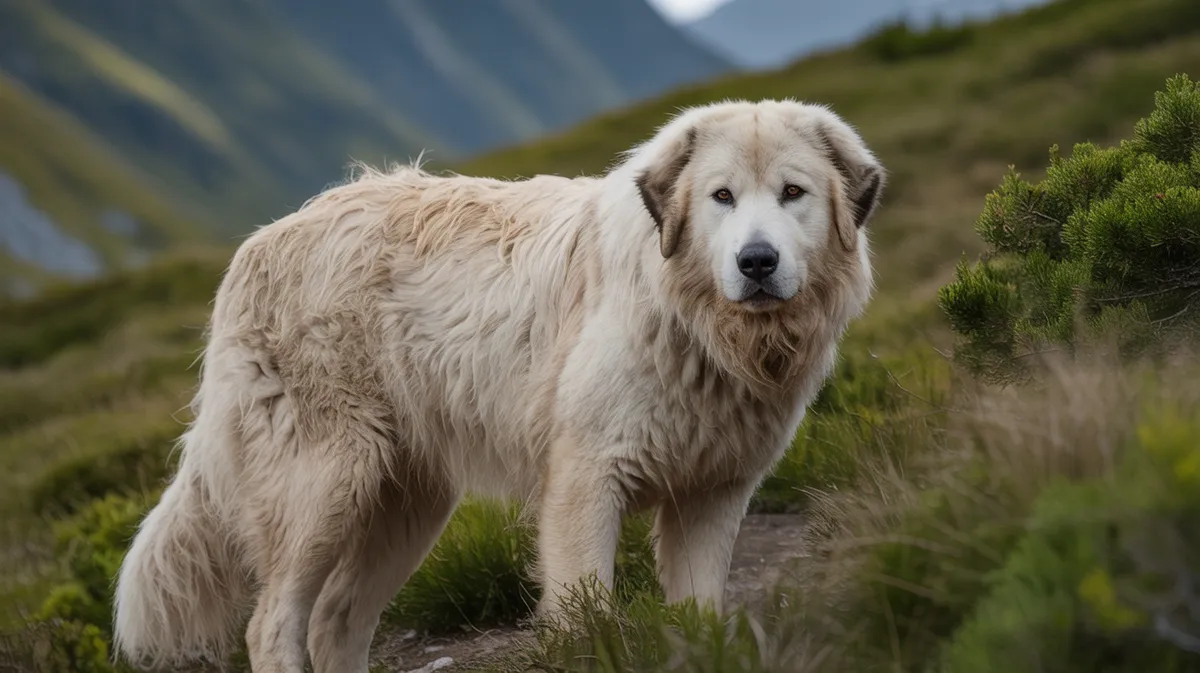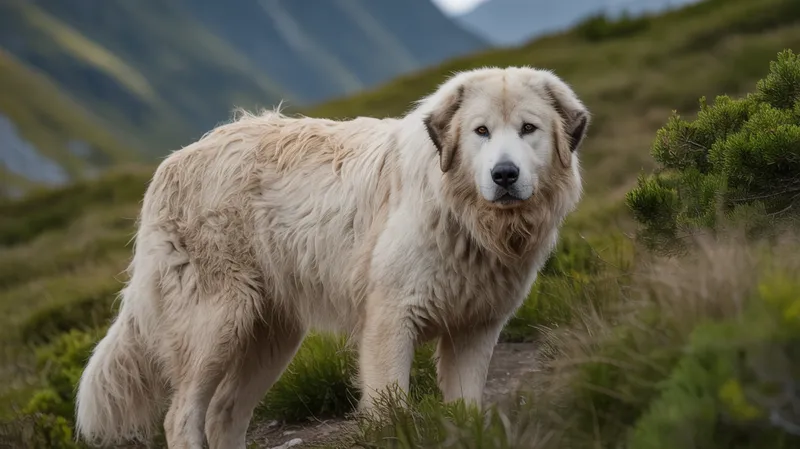
Great Pyrenees
Canis lupus familiaris

Meet the Great Pyrenees
The Great Pyrenees is a large, majestic dog breed originally developed to guard livestock in the rugged Pyrenees mountains of France and Spain. Known for their thick, weather-resistant double coat, these dogs are both powerful and gentle, displaying a calm, patient temperament ideal for working in harsh conditions. The breed is highly intelligent, independent, and protective, making them excellent guardians of flocks and families alike. Their dignified demeanor, loyalty, and striking appearance have made them beloved companions and working dogs worldwide.
Classification
Mammal
Habitat
Mountain
Diet
Omnivore
Lifespan
10-12 years
Conservation
Least Concern
Weight
38–54 kg (85–120 lbs)
📖Fascinating Facts
Natural Guardians
Great Pyrenees were bred to independently guard sheep and livestock without human direction, displaying strong protective instincts.
Weatherproof Coat
Their dense, double-layered fur repels moisture and insulates against both cold and heat, making them well-suited for mountain climates.
Nocturnal Watchdogs
Historically, Great Pyrenees are most active and alert at night, when predators are likely to threaten livestock.
📋Detailed Description
The Great Pyrenees (Canis lupus familiaris), also known as the Pyrenean Mountain Dog or Patou in France, is a large, robust breed developed for livestock guarding in the harsh, mountainous terrain of the Pyrenees. Adult males typically stand 70–82 cm (27.5–32 in) at the shoulder and weigh 50–54 kg (110–120 lbs), while females are slightly smaller. Their dense, weather-resistant double coat consists of a thick, woolly undercoat and a long, coarse outer coat, predominantly white with occasional markings of gray, tan, or badger. Anatomically, they possess a broad chest, strong limbs, and distinctive double dewclaws on the hind legs—a trait selected for agility and stability on steep slopes. The breed is renowned for its calm, patient, and gentle temperament, especially with children and livestock, but displays keen vigilance and assertiveness when protecting its charges. Great Pyrenees are highly intelligent and independent, traits essential for making autonomous decisions while guarding flocks. Socially, they are known to form strong bonds with their flock and human family, often working in pairs or small groups to maximize protection. Reproduction is typical of large breeds, with litters averaging 6–10 puppies. Their unique adaptations, such as acute hearing, a deep bark, and nocturnal alertness, make them exceptionally effective at deterring predators like wolves and bears. Despite their imposing size, Great Pyrenees are gentle, affectionate companions, valued for their loyalty, dignity, and steadfast guardianship.
💡 Did you know?
Despite their imposing size, Great Pyrenees are famously gentle and affectionate with children and other animals.
🔬Research & Sources
Wikipedia Summary
The Pyrenean Mountain Dog or Chien de Montagne des Pyrénées is a French breed of livestock guardian dog; in France it is commonly called the Patou. It originates from the eastern or French side of the Pyrenees Mountains that separate France and Spain and is recognised as a separate breed from the Mastín del Pirineo or Pyrenean Mastiff from the Spanish side of the mountains, to which it is closely related.
Last Modified: 6/6/2025
🎭Behavior & Social Structure
Great Pyrenees exhibit a strong territorial instinct, patrolling boundaries and responding vocally to perceived threats with a deep, resonant bark. They are primarily nocturnal in their guarding behavior, remaining vigilant throughout the night when predators are most active. Feeding behavior is typical of large omnivorous breeds, with a preference for high-protein diets, though historically they subsisted on what was available in remote mountain regions. Socially, they are independent but form close attachments to their flock or family, often displaying nurturing behaviors towards young animals and children. They use body language—such as positioning themselves between their flock and a threat—to communicate intent. Daily routines involve periods of rest interspersed with active patrols, especially during dusk and dawn. While not aggressive by nature, they will escalate from warning barks to physical confrontation if necessary to protect their charges.
👶Reproduction & Life Cycle
The breed reaches sexual maturity around 18–24 months. The female's estrus cycle occurs biannually, with breeding typically taking place in late winter or early spring to coincide with favorable weather for whelping. Gestation lasts approximately 63 days. Litters range from 6 to 10 puppies, though larger litters are not uncommon. Maternal care is pronounced; the dam is attentive, providing warmth, grooming, and protection. Paternal involvement varies but can include guarding the den area. Puppies are weaned at 6–8 weeks and begin socialization with livestock early, a critical period for imprinting their guardian role. Breeding programs emphasize temperament, health, and working ability to maintain the breed's traditional functions.
🛡️Adaptations & Survival
The Great Pyrenees' thick double coat insulates against extreme cold and repels moisture, essential for survival in alpine climates. Their large, muscular build and broad paws facilitate movement across snow and rocky terrain. The presence of double dewclaws on the hind legs enhances stability and grip. Behaviorally, their independence and problem-solving abilities allow them to assess threats and act without direct human guidance. Their acute senses—particularly hearing and night vision—are finely tuned for detecting predators. The breed's deep, carrying bark serves as both a deterrent and a means of communication over long distances. Their calm demeanor enables them to remain composed under stress, reducing the likelihood of unnecessary aggression.
📚Research Sources
🎨Cultural Significance
The Great Pyrenees holds a prominent place in the folklore and rural traditions of the Pyrenees. Historically, they were esteemed by French nobility; King Louis XIV declared them the 'Royal Dog of France' in the 17th century. The breed features in regional legends as protectors of villages and livestock against wolves and bears. Their image is often associated with strength, loyalty, and guardianship. In modern times, they serve as symbols of rural heritage and are celebrated in festivals and cultural events in the Pyrenees. The breed has also gained international recognition as a companion and therapy dog, valued for its gentle nature and imposing presence.
🔬Recent Research & Discoveries
Recent studies have focused on the genetic diversity of the breed, revealing close relationships with other European livestock guardian dogs, such as the Pyrenean Mastiff and Maremma Sheepdog. Research into working behavior has highlighted the effectiveness of the Great Pyrenees in non-lethal predator control, contributing to sustainable livestock management and biodiversity conservation. Ongoing health studies aim to identify and reduce the incidence of hereditary diseases through genetic screening. Behavioral research emphasizes the importance of early socialization and training in developing reliable guardian instincts. Conservation organizations are collaborating with shepherds to reintroduce the breed in areas where traditional pastoralism is being revived.
🎥Wildlife Videos

Guadalquivir – The Great River | Free Documentary Nature
Guadalquivir – The Great River | Wildlife Documentary Watch 'Wildlife's Rebirth - A True Natural Treasure' here: ...
Free Documentary - Nature

Exploring the Wild Nature of the Great Pyrenees
Great Pyrenees in the Wild: Understanding Their Natural Behavior The Great Pyrenees, also known as the Pyrenean Mountain ...
Great Pyrenee USA

Dogs Protect Herd From Wolves Caught in Night Vision | BBC Earth
When protecting a herd, a barking dog can scare off a lone wolf. But what about when a whole pack of wolves attack? These dogs ...
BBC Earth

THE AFRICAN WILD DOG: Nature’s Most Ruthless Pack Hunter Unleashed! | Animal Documentary
THE AFRICAN WILD DOG: Nature's Most Ruthless Pack Hunter Unleashed! | Animal Documentary THE AFRICAN WILD DOG: ...
WILD WORLD - Animal Documentary

Wildlife Stories: Nature’s Greatest Engineers | Free Documentary Nature
Wildlife Stories: Build or Die | Free Documentary Nature Wildlife Stories: Nature's Master Builders | Free Documentary Nature ...
Free Documentary - Nature

Wild Canada - Nature's Untamed Beauty | Full Series | Free Documentary Nature
Wild Canada - Nature's Untamed Beauty | Wildlife Documentary Watch 'Darkwoods - Canada's Hidden Nature Reserve' here: ...
Free Documentary - Nature
🌍Habitat Information
The Great Pyrenees typically inhabits Mountain environments. Great Pyreneess have adapted to their environments with specialized features and behaviors.
Primary Habitat:
Mountain
More detailed habitat information will be available soon.
🛡️Conservation Status
The Great Pyrenees is currently classified as Least Concern. Conservation efforts are crucial for preserving this species for future generations.
Common Threats:
- 🏠Habitat loss and fragmentation
- 🌡️Climate change impacts
- 🎯Hunting and poaching
- 🏭Human-wildlife conflict
⚠️Threats & Conservation Challenges
While the Great Pyrenees is not considered at risk globally, several challenges affect the breed. In their native regions, changes in pastoral practices, declining numbers of traditional shepherds, and reduced predator populations have diminished their working roles. In some areas, hybridization with other large breeds and irresponsible breeding practices threaten genetic integrity. Health concerns include hip dysplasia, osteosarcoma, and certain hereditary conditions such as entropion. In regions where they are used for livestock protection, conflicts can arise with local wildlife management policies or when dogs roam beyond property boundaries. Population trends remain stable in most countries, with active breed clubs promoting responsible ownership and conservation of working lines.
🔬Scientific Classification
Scientific Name
Canis lupus familiaris
Classification Hierarchy
🔍 About Taxonomic Classification
Taxonomic classification is a hierarchical system used by scientists to classify and organize living organisms based on shared characteristics and evolutionary relationships.
The system moves from broad categories (Kingdom) to increasingly specific ones, with each animal's scientific name typically consisting of its Genus and species.
📝Community Notes
Share your observations and insights about the Great Pyrenees with our community of wildlife enthusiasts.
Join Our Community
Sign in to share your observations and connect with fellow wildlife enthusiasts.
Sign In to ContributeNo community notes yet
Be the first to share your observations about the Great Pyrenees!
Explore Great Pyrenees
Select a tab above to learn more about this amazing animal.
📸Photo Gallery
No photos available for this animal yet.
🌟Discover More Wildlife
Continue your journey of discovery with more fascinating animals from our database
